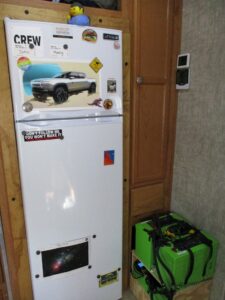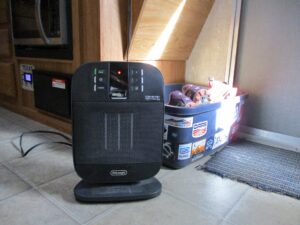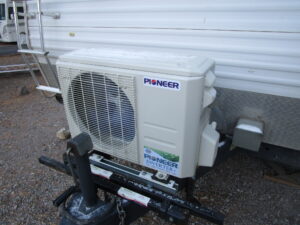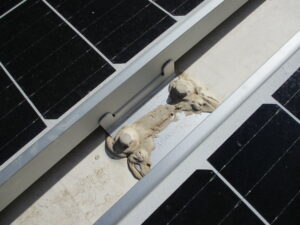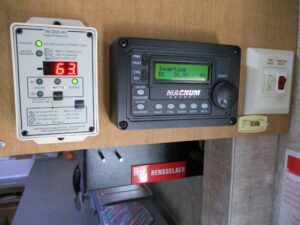At the start of a new year, it feels like time to look back, summarize our electrification progress, and create a template with considerations for anyone else looking to follow a similar path.
Our focus is on the living space within our travel trailer, which we have converted to all-electric power. It could easily apply to RV’s and tiny houses, and also scale up to larger houses without much imagination.
I have a goal of creating a guide and/or worksheet for personalized energy calculations, with links to additional resources and products. For now, I’m starting below with a few things to think about. Feedback, as always, is welcome! Let me know if you find this useful, and whether you could use a more specific plan for your situation.
Thinking big
In general, you’re going to have the biggest, longest-lasting positive impact with several major changes to your living space. For sure, this requires up-front planning, money, and time. The upside is that once you make these changes, it’s done and you can enjoy all the benefits for years.
Benefits like cleaner air, quieter appliances, reduced energy costs, less maintenance, and better health (see especially this study linking health concerns to gas stoves).
And of course, less CO2 emission, which is much harder to see but important for everyone on the planet in the long run.
For our travel trailer, the Big Things are:
- Heating (during cold months)
- Air conditioning (during hot months)
- Refrigeration (at least, it used to be a “big thing”)

Barely significant, energy-wise:
- Water heating (depending on usage)
- Refrigeration (now with the new fridge)
Not significant, in terms of energy requirements:
- LED lights
- Cooking food (or maybe we just don’t cook as much as some people)
- Heating water for hot drinks
- Charging electronics
- Water pump
- Fans
- I’m sure I’m missing some things; that’s how much we don’t think about all the details

In a travel trailer, focusing on the Big Things means thinking about a better refrigerator and switching to a heat pump. Simple! Well, OK, not always simple. But at least narrowed down to two major items.
Starting small
On the other end of the spectrum, no one needs to go all-in right away. Dip your toes in the electrification waters – wait, that doesn’t sound right…
Let’s try again.
What are some smaller items that currently use propane that have an electric alternative? Or that use less electricity than what you have now? Especially the ones which are easy to experiment on without running wiring or putting holes in walls.
Possibilities include:
– An electric kettle for heating water to drink. Our friend Marc suggested this to us last year, and now we use it almost every day. Love it!
– LED lights to replace as many lights in your house as possible
– An electric space heater for focused floor heat instead of running a loud blower and propane heater
– A stand-alone induction cooktop plus one induction-compatible pot; a simple starter kit without needing to modify your entire kitchen
This can be a fun way to begin making little changes without a huge investment.
Electric considerations
When thinking about switching to electric appliances, here are a few items you might take into account:
– Refrigerator: We started with the factory-installed fridge in our 2007 Jayco trailer. It ran both on propane and electricity. So we could seamlessly switch to all-electric living without upgrading this appliance. However, the electric side of that fridge was a huge energy hog. Boondocking in that manner was almost out of the question.
We went through a long saga involving modification, Arduino control, and lots of learning. It would have been a big headache if we hadn’t been so excited to learn so many new things along the way.
But the easiest, most obvious, and now Beard-recommended method is to change out the refrigerator for a DC “solar” fridge. We’ve lowered our electricity usage for this one appliance to a small percentage of what it used to be.
Since this is the one item that HAS TO WORK, all the time, it is the first big item to tackle for an all-electric conversion.
– Air heating and cooling: We started with a loud rooftop AC unit and a propane heater with loud blower. Current heat pump/mini-split technology is such an improvement, it’s almost a no-brainer. Except for the question of longer-term reliability when mounted in a mobile living space (TBD), everything else about it is clearly superior.
This includes energy usage, simplicity, ability to both heat and cool with one unit, noise reduction, and the fact that we hardly notice when it’s on. I would guess also a lower cost to heat and cool, although I don’t have solid numbers for that so don’t quote me on it.
I have to imagine this is something the RV manufacturers are looking at already, or at least I sincerely hope so.
– Cooking: Induction cooktops are similar to gas stoves in that they heat quickly and you have precise, fast control over the temperature. They are similar to electric stoves in that they don’t emit toxic gas and can’t explode (although John thought I should clarify that explosion is highly unlikely). Best of both worlds.
The biggest consideration is the requirement for induction-specific cookware. If a magnet sticks to the bottom of the pot/pan, it will work on induction. Otherwise, nope.
So this is an “opportunity” to go shopping. I was thrilled to find a set of stackable pots that greatly reduced the amount of pantry space required. Except for the cost of switching over, it was a win-win improvement in cooking technique plus space savings.


We also now have:
- A toaster oven (crunchy bagels, yay!)
- An Instant Pot (game changer for beans, soups, potatoes, vegetables, and many other things we still want to experiment with)
- An electric “Billy” kettle (hot water in the winter is so appreciated)
- And of course, the microwave, as always (a new one because the old one was getting, well, old)
– Water heating: The sole remaining factory-installed appliance in our trailer is the water heater. It works both on gas and electricity, so we didn’t need to make any modifications when we removed the propane from the trailer.
Wow, this water heater has obviously been with us for a while – and it still works:
A future project will likely entail researching alternatives and possibly doing an upgrade. Or adding a timer or temperature controller of some type. For now, we manually turn on the water heater mostly only before we shower, so it doesn’t require a lot of energy.
– Space modifications: When we (and by “we” I mean John) started removing all the parts of the propane system, we couldn’t believe how much room it was taking up. Most of that, like the ductwork, is hidden under counters. More visible were the propane tanks sitting on our front hitch.
We replaced the propane tanks with the outside part of the heat pump. The batteries moved in where the propane generator used to be.
And then the batteries moved inside, partly for climate control (keeping them from freezing this winter) and mostly so John could start installing the next battery upgrade.

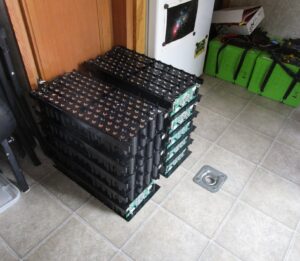
We could have replaced the stovetop with an induction version, but for now we are using a single burner induction cookset (I’m trying to think of an electric alternative to the word “burner” but can’t come up with one off-hand) since we don’t do a ton of multi-pot cooking. The cookset lives in a drawer and John replaced the stovetop with a countertop. That doubled the amount of counter space, a luxury in a 19′ travel trailer.
Now we have room for the toaster oven and electric kettle (breakfast anytime) while still allowing us to work side-by-side in the kitchen instead of taking turns. Convenient AND “counter-productive” in the good way.
Even more room: Roof space with the AC unit gone, a couple extra kitchen drawers, and an entire hidden shelf where we can hoard store paper products in preparation for any possible pandemic.
I’m sure John will also think of something to do with the little nook where the propane detector currently sits idly by, wondering what it’s still doing there.
– Time savers: It’s the little things, but I no longer have a maintenance list that includes filling battery water (no more distilled water), verifying the generator oil level, checking the fridge flame, and equalizing the batteries.
We also never need to refill the propane tanks. We’re hoping to never need to use a gas pump again, but that’s another story for another time.
Solar and batteries (and boondocking)
We love this topic, and it’s an important piece of worldwide sustainable energy generation. Well, not the boondocking, but the other two. It’s also an excellent way to make your system more robust. Distributed solar should be part of a more flexible energy system in all communities.
But it’s not a requirement for each person individually. Every situation is different and some homes (including the mobile ones) aren’t easily adaptable for solar panels.
I’d suggest that a battery backup system is more and more obviously useful and will someday become something people decide is a requirement. This is especially true on an RV/travel trailer, which all come with at least a minimal battery.
For a travel trailer owner, if they mostly stay connected to power posts in RV parks, they probably don’t need to think about better batteries or solar panels.
As soon as you start boondocking, solar and batteries create a great deal of independence and flexibility. We love being able to travel for days at a time, park in a national forest for a week, stop over in someone’s driveway (or Harvest Hosts location), head out into the hinterlands, and occasionally pop into an RV park for a night to dump the tanks and refill water.
In designing such a system for a mobile rig, we tend to approach it differently than for a larger home. Normally for residential solar, the calculations start with amount of usage (first question = what does your utility bill look like?). For an RV or travel trailer, John says, “put as much solar on the roof as you can fit.”
For us, this meant removing the TV antenna (never used it) and skylights (that leaked), and moving the refrigerator vent (the new non-propane fridge doesn’t need it).
It also helped immensely to get rid of the roof air conditioning unit. What a joy! Imagine losing several inches of trailer height, at the same time getting rid of that loud contraption. This is one of several advantages of the heat pump.
We have a 19-foot travel trailer with 1580 watts of roof solar.
For the batteries, John says, “go with lithium, and get as much as you can afford.” Once you factor in the useable capacity of lithium compared to the other options, plus compare the weight savings, you start to see that it’s not simply a question of cost per kilowatt-hour.
Our battery system is currently about 6.3 kWh of storage, with about 11 kWh in the wings waiting to be installed.
The main calculation on the battery side is “number of days you can last without recharging (from solar or the grid)”. For someone in a house, this will give you an estimate of how long the grid could be down and you would still have power for the primary systems.
For a travel trailer, the worst-case situation tends to look like “I’m boondocking in Washington State and it’s raining for 7 days straight and we’re parked in the middle of a dense forest” (not that this has ever happened to us).
We would likely leave the inverter (AC electrical system) mostly turned off except for occasional cooking. Hopefully we’d have access to showers somewhere, to save water and electricity. And ideally the outdoor temperature isn’t crazy hot or cold, as we can survive a fairly wide range without climate control, if we need to.
I estimate that we could reasonably live on 1 kWh per day if we’re careful, meaning we could last ~5 days without any recharging.
And even in the forest in the rain, the solar panels tend to collect a small amount of energy, so we could probably go longer and/or use more electricity.
In the opposite scenario, we can boondock in the desert in full sun and still have air conditioning, without ever running out of power. We routinely collect 6 to 7 kWh of energy via the solar panels each day and top off the batteries without even trying. Actually, using every bit of energy we could possibly collect is the challenge in the summer.
The main point being that we have flexibility, sans propane. And you can too!
Disclaimers
– When we’re boondocking, we pay close attention to the weather forecast. It helps a lot to know whether we need to be careful with energy usage because of an upcoming rainy week or whether we’re likely to have full sun in the foreseeable future and can use a lot of battery energy without worrying about recharging.
– In the winter, if we’re living in a cold (or at least chilly) place and especially if we don’t have a lot of sunshine on the roof, we require an electric hookup for the trailer to run the heaters. Heating takes a lot of energy, and there’s a break-over point where we need more than our solar panels can bring in.
Some future year, maybe next year, we’d like to try wintering in a warmer location where we don’t need the heaters as much. Perhaps then the reduced daylight hours will still be enough to power us full-time. Or not, but it would be helpful to find out.
– Here’s a big disclaimer – John is super handy and does all of our own work on the trailer. This makes a difference when we’re mulling over modifications and dealing with repairs and unexpected occurrences. It gives us plenty of freedom for experimentation.
If it were just me sitting here dreaming up big ideas, a lot of this would not have happened. Even knowing now exactly what John has accomplished, it would be expensive (and probably challenging) to find someone else to repeat all of it.
I’m certain there are plenty of other people who could do similar work, and perhaps this is a “job of the future” – electrifying the living spaces of RV’s and travel trailers. Now that we are experiencing the benefits, it’s possible for me to imagine other people wanting to do something along the same lines.
Even more ideally, the dream future is where all RV’s and travel trailers already come this way from the beginning. Wouldn’t that be great? Start asking for that whenever you go shopping for one at a dealer.
– Until that happens, renovations cost money. We’re lucky to have the ability to pay for the parts and supplies, and as noted above, we’re very lucky to have John’s expertise and time to do the work.
I’m sure we’re saving some money in the long run – no propane purchases, for example. But I’m also sure we’ll never make up what we have spent.
It has to be about more than just the money. For us, it’s the enjoyment of experimentation, the health benefits, the noise reduction, and the chance to make at least a tiny difference in the world.
Finer points and details
Here’s where I get somewhat more technical, so feel free to skip this section if you aren’t interested in digging deeper.
If you are thinking of DIY’ing part or all of an electric conversion, we’ve compiled a partial list of things you might need to consider. If I go into any more depth, this blog post will never get published, and I’m trying to “not let perfect get in the way of good enough” right now.
Again, this is an incomplete list and will vary a lot depending on your situation and decisions about what to tackle. Feel free to message me with questions about any of it.
Things to consider:
– What you currently use propane for, and what can be swapped for an electric version
– The potential benefits for you
– What order to do which work
– Sizing and installation of a new DC refrigerator
– Maximum amount of amperage you can use at one time; does your rig plug into a 30 amp or 50 amp outlet? Sizing the system within these limits is probably helpful
– Along the same lines, when you start electrifying everything, it’s good to know how much electricity each appliance is using (especially those with heating elements) so you don’t ask for too much at one time and trip a breaker
– Your typical electricity usage numbers, which will vary by season. Mostly focus on the big things – refrigeration, heating, cooling, and anything else that pulls a lot of power or is on all the time at medium power
Side note: Calculations got easier when we switched our thinking to watts (amps multiplied by volts); regardless of whether it’s the AC or DC system and how many volts, the wattage translates across all pieces of the puzzle. And it converts directly to energy (kilowatt-hours).
– Where to put batteries and electronics vs. what can be removed (and how to use that space)
– Temperature control for the batteries – keep in mind that lithium batteries should not be charged when the batteries are in freezing or super-hot temperatures, so it’s helpful to have them in a more controlled environment. Most drop-in batteries have a monitor system (BMS, or battery management system) to automatically check for temperature before allowing them to be charged
– Solar panel layout, any changes to the roof, and if the roof needs work, it’s usually best to finish that first
– Battery bank voltage (12 volts, 24 volts, 48 volts, other?). Higher voltage allows for thinner wires. Consider compatibility with an inverter, DC fridge, other electronics. If the battery bank voltage is anything other than 12 volts, you will need a converter to provide 12 volts for the standard DC items like lights, water pump, etc.
– Wire sizing – make sure the wires can handle the required amperage
– Proper waterproofing for running wires
– Method for securing solar panels to the roof
– Electronics that are necessary or helpful, including a battery monitor (much better than “flying blind”), charge controller for moving electricity from solar panels to batteries, inverter (properly sized) for taking battery energy and changing it to AC for outlets and appliances, any converters for changing DC energy from one voltage to another
– Disconnects, fuses, breakers…
And try not to get overwhelmed?
It feels like John could create an in-person training class where a trainee would poke all around the work that John has done on Howie and then spend some time in/under/on top of their RV or travel trailer gathering ideas and talking through potential suggestions and challenges. Especially if someone were already knowledgeable about the ins and outs of their home and able to tackle the mechanical and electrical pieces involved.
In an ideal world…
What if we were designing our home-on-wheels from scratch? What would we include and what would it look like?
That is probably a topic for another time. Send me your ideas and I’ll start a file.
Hey, wouldn’t it be great if RV’s and travel trailers simply CAME THIS WAY? If you take away one thing from this, the next time you’re out shopping for one, ask about it. Start putting attention on it. Get the manufacturers to think about it.
This goes for new houses as well.
Maybe someday this whole blog post – heck, maybe this whole website – will be obsolete. A win for everyone!
